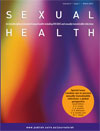
Sexual Health
Volume 9 Number 1 2012
Condom Use to Prevent Sexually Transmitted Infections: A Global Perspective
SH11901Preface to 'Condom Use to Prevent Sexually Transmitted Infections: A Global Perspective'
This article introduces and summarizes the contents of this special edition. Given the exceptional potential of condoms to avert epidemics of sexually transmitted infections and teen or unintended pregnancy – even in low-resource environments – this in-depth examination of current knowledge, practice, and issues with condoms and their use is an important asset for educators and practitioners worldwide.
SH11072 Condom use around the globe: how can we fulfil the prevention potential of male condoms?
Despite a global epidemic of sexually transmissible infections and the availability and endorsement of condoms as an effective intervention, the overall use of condoms remains low. This review explores various challenges and opportunities to fully realizing the prevention potential for condoms.
Although several forms of inherent bias create underestimates of condom effectiveness, a review of prospective studies suggests that a high degree of protection against most sexually transmissible infections is provided through the consistent and correct use of condoms. Improved studies should focus on several key issues, including those relevant to the selection of a recall period, improved precision of self-reported measures, and accounting for condom use errors and problems.
SH11036 Abstract | SH11036 Full Text | SH11036PDF (237 KB) Open Access Article
SH11037 A review of the effectiveness and acceptability of the female condom for dual protection
The authors reviewed data on the effectiveness and acceptability of the female condom for protection against pregnancy and sexually transmissible infections (STIs), including HIV. The data available suggest that female condoms (or a mixture of female and male condoms) may provide similar degrees of protection against pregnancy and STIs as do latex male condoms alone; however, this conclusion has not been demonstrated and thus comparative research is urgently needed..
SH11021 Condom use in China: prevalence, policies, issues and barriers
In this article we review condom use in China, with a focus on the populations that are at high risk for HIV/sexually transmissible infection. We also review policies related to condom promotion and the challenges facing this endeavour and tend to provide recommendations to promoting condom use in China.
SH11025 Review of HIV vulnerability and condom use in central and eastern Europe
This review article summarizes findings of sexual behavior research studies recently carried out in central and eastern Europe. This world region has seen one of the most rapidly increasing HIV epidemics, which coincided with fundamental political, economic, and social transformations. Studies of injection drug users, commercial sex workers, men who have sex with men, adolescents and young adults all reported inconsistent condom use. Risk behavior patterns are discussed, and public health recommendations are being suggested.
SH10165 Condom social marketing in sub-Saharan Africa and the Total Market Approach
Condom social marketing interventions deliver risk reduction messages and about one-quarter of all condoms used worldwide. The primary challenge today is for social marketing agencies and their stakeholders, public and commercial sector supply sources, to collaborate to achieve universal coverage of condoms among the vulnerable while increasing cost-effectiveness and equity..
SH11011 Progress and challenges to male and female condom use in South Africa
In South Africa male condoms are available widely in the public, social marketing and the private sectors. The female condom program is well-established. Increasing condom use rates at last sex are reported; however, inconsistent and incorrect use are major challenges impeding the condom program’s success. This article reviews current condom guidelines, policies, distribution and uptake. We discuss the main challenges to condom use, including both user and service-related issues.
This paper synthesizes published research on condom use in sub-Saharan Africa. The literature supports a conclusion that the complexity of social and interpersonal dynamics within structural and cultural conditions creates barriers to condom use. Yet, trends towards increased use are also evidenced among single women and university students as well as the success of select interventions in some regions.
SH11033 Abstract | SH11033 Full Text | SH11033PDF (417 KB) Open Access Article
SH11004 Dual use of condoms and contraceptives in the USA
The use of condoms in conjunction with other contraceptive methods has substantial benefits for both pregnancy prevention and STI prevention, but rates of dual method use in the USA are comparatively low. This article reviews the literature on trends and covariates of dual method use in the USA, identifying those factors most strongly associated with dual method use and identifying key areas for future research and interventions.
SH11095 Condom use errors and problems: a global view
This review finds condom use errors and problems are common worldwide, occurring across a wide spectrum of populations. Breakage and slippage were the most commonly investigated, but other more prevalent and correctable errors and problems: 1) may contribute to condom breakage and slippage outcomes or; 2) may themselves represent a more likely threat of exposure to sperm or pathogens than those resulting from breakage and slippage.
SH11095 Abstract | SH11095 Full Text | SH11095PDF (357 KB) Open Access Article
SH11091 Condom migration resulting from circumcision, microbicides and vaccines: brief review and methodological considerations
Condom migration, the common practice of couples abandoning condom use after adopting a similar protective behavior, continues to undermine innovations in HIV preventions. This article reviews studies investigating migration from one contraceptive method to another contraceptive and studies investigating migration from one disease prevention method to another. The results provide an updated review of condom migration as a means of highlighting methodological issues for future studies of this behavioural issue.
Although historically, sexuality-related issues have received little systematic attention in the field of public health, researchers are now paying more attention to the role of pleasure and sexual arousal in condom use. In this commentary, it is argued that a better integration of findings from the area of sex research into the HIV and sexually transmissible infection (STI) field is needed to develop and improve programs to reduce the risk of STIs and unintended pregnancy.


